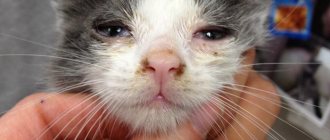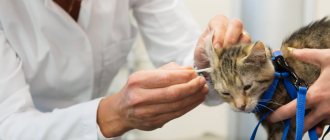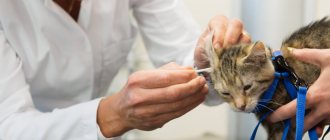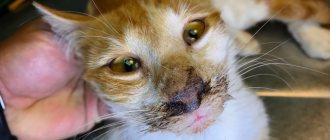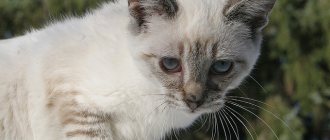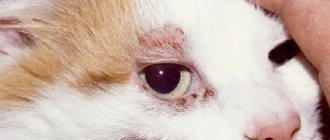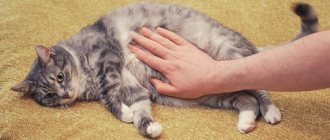Causes of infection with rhinotracheitis Symptoms Diagnosis Treatment of rhinotracheitis in cats Prevention of rhinotracheitis Rhinotracheitis in cats, or herpesvirus, is a viral disease that affects the respiratory tract, usually does not cause significant deterioration of the condition, except in kittens and animals with weakened immune systems, and is rarely fatal. Most often accompanied by fever and discharge from the eyes and nose.
Rhinotracheitis virus belongs to the herpesvirus family and is therefore also called “feline herpesvirus”. Mortality of cats due to herpes virus is rare; usually deaths are associated with the general severe condition of the animal, dehydration, and the development of a secondary bacterial infection, which can lead to bronchopneumonia. However, cats that have recovered from the disease often remain carriers and may then experience relapses of the disease throughout their lives, sometimes developing chronic rhinitis (inflammation of the mucous membranes of the nose) or conjunctivitis.
Viral rhinotracheitis of cats is not transmitted to humans and does not pose a danger to the owner. The main carrier of this viral disease is cats. Most often these are stray animals or animals living in large groups in a limited area (for example, in large nurseries or in group housing). The domestic cat is the main carrier of the herpes virus, although antibodies to this disease have also been found in groups of cheetahs, lions and pumas.
Brief description of the disease
Rhinotracheitis occurs in cats as a result of infection with the feline herpes virus FHV-1 (Feline Herpes Virus type -1), a DNA containing virus of the herpesviridae subfamily. It is the most common causative agent of inflammation of the respiratory system of animals, along with mycoplasmosis, calcirovirus and chlamydia. Known among cat owners as cat flu or feline pneumonia.
Herpesvirus is characterized by rapid reproduction in animals with the destruction of healthy cells. It is a double strand of DNA located in the spherical shell of the captured cell.
FHV-1 provokes the disease not only in domestic animals, but also in all classes of cats. In 1977, the death of eight leopards at the Seville Zoo was recorded during a single outbreak of the disease. Cases of herpesvirus infection of wild cats in Asia, Africa and Europe are known and described in the scientific literature.
The disease is widespread among domestic cats in Russia, Canada, the USA, South Africa, India, Australia and almost all countries of Western and Eastern Europe.
The mortality rate among adult cats is quite low, but this disease poses a great danger to animals due to complications and secondary pathologies caused by the virus.
The incubation period of infection is from two to ten days. The herpes virus is transmitted to healthy animals from sick or recovering cats through saliva, eye discharge and muconasal secretions. The paroxysm of the disease causes coughing and sneezing in cats, and an additional factor appears for airborne infection.
Initial symptoms in animals disappear two weeks after the start of symptomatic therapy. Complications after suffering rhinotracheitis affect both the respiratory system and the gastrointestinal tract, causing ulcers of the mucous membranes of the pharynx and skin, diseases of the nasal passages and eyes.
Most adults tolerate the infection quite easily, and the prognosis is favorable.
Newborn kittens, babies up to three months and young animals are more seriously ill. A special risk group is pregnant individuals. Sometimes the pathology leads to spontaneous abortion, more often to the birth of infected kittens, and intrauterine pathologies of fetal development are not uncommon.
In almost half of the cases, rhinotracheitis is accompanied by calcivirosis, and the disease occurs in more severe forms.
There is no description of seasonal outbreaks of rhinotracheitis in the scientific literature, but veterinary practice shows that the largest number of acute cases of infection by the virus occur in the autumn-spring and winter periods.
The causative agent of the disease
The symptoms of the disease are similar to viral diseases such as chlamydia, mycoplasmosis, and calcivirus. Therefore, only a doctor can accurately diagnose the disease. Herpesvirus requires special treatment; in order for the animal to fully recover, all veterinary recommendations must be strictly followed.
All cats are carriers of the herpes virus Herpesviridae from birth. In some animals it may remain in remission throughout their lives. Others are less fortunate and the infection manifests itself one day. At the first symptoms of the disease, rush to the doctor and get treatment immediately. Otherwise, the activated pathogen will provoke the development of immunodeficiency, leukemia and the death of the pet.
In young animals, rhinotracheitis causes:
- damage to the upper respiratory tract;
- diseases of the conjunctiva;
- ulceration of the cornea with the risk of developing malignant tumors.
That is why treatment of herpes should be as fast as possible; in advanced conditions it can be ineffective, and sometimes even in vain.
How is the virus transmitted and is it dangerous to humans?
Herpesvirus is easily transmitted in the following ways:
- Discharge from the eyes, nose, or mouth of a sick or infected animal.
- When using toilet trays, water and food bowls shared with the virus carrier.
- Airborne through sneezing and coughing in animals with secondary pathology.
- In utero from mother to offspring.
Infection through secondary care items - cat houses, beds, combs and other tools for caring for a cat - is not as likely as with calcivirus, since the herpes virus is even less persistent.
Outside the animal’s body, the virus dies after 1-2 days, is unstable in sunlight, and is destroyed by high temperatures and the use of chlorine-containing disinfectants.
Cases of infection of pets through the hands, clothes and shoes of the owner are also extremely rare.
In the cold season, during the rainy season, and with high humidity, the risk of infection with feline rhinotracheitis increases.
The degree of damage to animals is much higher if they are kept crowded. This issue is especially painful for nurseries and shelters for homeless animals.
There have been cases of infection from an apparently healthy animal that is a latent carrier of the herpesvirus FHV-1.
A cat that has recovered from the disease clearly remains an active carrier of infection. Up to one and a half years, all the secretions of a recovered pet pose a danger to the cats around it. In latent form, the herpesvirus FHV-1 remains in the cat’s blood for life.
This virus is not dangerous for humans and other domestic animals; infection does not occur through contact with a sick cat.
Discharge from a cat's eyes, which is characteristic of rhinotracheitis, can be confused with other ophthalmological diseases, so read the article about them here to figure it out.
Which cats are prone to contracting the herpes virus?
Cats of all sizes, ages and breeds are at risk of contracting this disease. However, cats living in crowded or stressful conditions with weak immune systems are more severely affected, as are kittens, Persians and other brachycephalic (flat-faced) breeds. Risk factors also include lack of vaccination against FHV-1, poor room ventilation, and cold. Other infectious diseases can also make a cat more susceptible to the herpes virus.
Symptoms of rhinotracheitis
When a pet is infected with the FHV-1 virus, it does not immediately fall ill; several stages can be distinguished in the development of the pathological process:
- Infection. Occurs directly upon contact of animals with a carrier or through primary care items.
- Incubation period. Small kittens and unvaccinated individuals can become ill within 24 hours to ten days. Adult healthy animals can get sick in a latent form; sometimes the herpes virus does not manifest itself for months or even years. Under unfavorable conditions (stress, weakening of the body due to illness or natural causes), pathogenic antibodies grow.
- The period of first symptoms. Over the course of several weeks, necrotic areas appear on the animal’s body—the sites where the virus enters—most often the mouth and nose. Discharge from the nose and eyes and fever appear. After fourteen days the disease usually progresses to the next period.
- Postclinical phase of the disease. Symptoms decrease, but without timely help, chronic rhinotracheitis develops. The animal is a carrier of the virus; exacerbations occur during stress or weakening of the body.
- Virus carriage. Up to one and a half years, the animal is an active virus carrier and, most likely, a passive one for the rest of its life.
The following factors will help determine the disease:
- the animal becomes lethargic, apathetic, depressed;
- loss of appetite, in the acute phase, complete refusal of food and feed;
- the mucous membranes of the mouth and nose become red and inflamed, the eyelids are also affected;
- serous discharge appears from the eyes and nose;
- the condition of the sick individual is aggravated by sneezing and coughing;
- lacrimation and conjunctivitis;
- muconasal and oral discharge becomes purulent;
- ulcers appear on the nose and mouth, often dry crusts on the nose;
- body temperature rises to 40 degrees, usually lasts for three days;
- due to copious nasal and oral secretions, vomiting may occur;
- intestinal atony is often aggravated by constipation;
- enlargement of the submandibular lymph nodes;
- Respiratory depression, wheezing when inhaling may develop, and bronchopneumonia progresses.
Vaccination
To reduce the risk of infection and the need for subsequent long-term treatment of rhinotracheitis in a kitten, follow the timing of routine vaccination. The herpes virus vaccination is part of the Purevax complex vaccine, which is administered at the age of 8 weeks.
Vaccination against herpesvirus is acceptable for all cats, regardless of their lifestyle.
Purevax RCP and Purevax RCPCh vaccinations for vaccination against herpesvirus are used according to the following scheme:
- 2 months – Purevax RCP or Purevax RCPCh
- 3 months – Purevax RCP or Purevax RCPCh + Rabizin
- After a year and then annually - Purevax RCP or Purevax RCPCh + Rabizin
Read more about the Purevax vaccine
Read more about first vaccinations for kittens
Diagnostics
To combat feline herpes virus, the first step is making a diagnosis. You need to contact a veterinarian.
Methods of modern veterinary diagnosis of herpesvirus:
- description of the medical history;
- immunofluorescence analysis (IFA) of swabs from the nasal mucosa and conjunctiva of the eyes;
- PCR diagnostics (polymerase chain reaction) of swabs from the mouth, nose and eyes to detect antibodies to the virus;
- blood smear for the histochemical version of enzyme-linked immunosorbent assay (ELISA);
- laboratory tests of urine, feces, blood to exclude leukemia and other infections;
- asculation, examination of the upper respiratory tract and tonsils to determine complications;
- radiography to detect bronchitis and pneumonia.
Treatment
It is based on the use of symptomatic remedies that are aimed at eliminating secondary inflammatory processes in the upper respiratory tract, bronchi, lungs, oral cavity, stomach and intestines. In order to suppress the development and reproduction of secondary infections, a variety of broad-spectrum antibiotics are used. To increase immunity at the early stage of the disease, heterogeneous serum, specific and nonspecific immunoglobulin, neoferon, interferon, anandin, thymogen, thymalin, etc. are used. In the process of treating sick cats, comfortable conditions are created and diet therapy is prescribed, enriching the diet with vitamins and microelements.
Therapy at home
After identifying the herpes virus FHV-1, the veterinarian will prescribe specific treatment for the cat. There are no drugs to suppress the virus itself; therapy is symptomatic.
Complex therapy for this infection includes:
- antibacterial drugs;
- antiviral agents;
- immunostimulating drugs;
- nasal drops to ease breathing;
- medicines for the treatment of eyes and mouth;
- maintenance therapy.
First of all, it is necessary to isolate the sick animal, provide it with a separate litter tray, bowls for food and water. He should be given proper care. To prevent complications from developing, avoid hypothermia of the sick individual.
Dietary food during illness, preferably from a special line of wet food. Food should be given warm to stimulate the appetite, as the cat's sense of smell is weakened due to nasal congestion.
If a cat refuses to eat and drink completely for more than three days, it is necessary to use droppers (in a veterinary clinic) or subcutaneous infusions, which can be administered independently as prescribed by a doctor. Use saline, glucose, and Ringer-Locke solution to prevent dehydration of the body. B vitamins and ascorbic acid are often added to the infusion mixture. In severe cases, hospitalization of the animal to a veterinary clinic is indicated.
To facilitate the breathing of a sick individual, the use of air humidifiers, inhalations and nebulizers helps well. The nose and mouth must be cleaned of mucus and pus and treated with special animal products. If ulcers have formed, use Iodinol, Chlorhexidine, Solcoseryl gels and ointments, Actovegin.
To combat nasal congestion, there are special drops Anandin, Maxidin, Interferon, and others.
Antibiotics are used to prevent complications and additional infections. Usually these are third generation cephalosporins - Ceftriaxone, Cefazolin. Along with this therapy, probiotics (for example, Villot probiotic drink) should be introduced into the animal's diet.
Antipyretics are used only when the temperature rises above 40 degrees Celsius - Ketofen, Loxicom, others.
It is strictly forbidden to give paracetamol-containing products to animals.
Immunomodulators and antiviral drugs
In the treatment regimen for rhinotracheitis for cats, it is necessary to use drugs aimed at increasing the body’s immune forces - the immunomodulators Immunofan, Fosprenil, Polyoxidonium, Cycloferon. Veterinary drugs – Anandin, Roncoleukin, Gamavit, Gamapren.
Antiviral drugs are used to reduce clinical signs of infection. The following methods are used:
- Systemic antiviral prescriptions - Famciclovir is an antiherpes drug used to treat humans. The method of administration is oral, safe for animals, and has an excellent therapeutic effect. The use of antiviral serums for cats (Vitafel-S, Globfel) is indicated.
- Therapy of conjunctivitis using antiviral drops and ointments. Sometimes the damage to a cat's eyes during the course of the disease is significant, even requiring surgical removal. Therefore, it is necessary to pay special attention to their treatment. Using eye drops for people Cidofovir, Trifluridine, Idoxuridine will help prevent the development of keratitis.
How can I help my infected cat feel better?
- Rub your eyes frequently (discharge can dry out, creating hard, uncomfortable crusts).
- Moisturizing your cat's environment or occasionally taking her to a steaming bath or inhaling will help relieve nasal congestion and make breathing easier.
- Create a calm, cozy atmosphere in the home.
- Make sure your cat is constantly eating and drinking water.
- Isolate the infected cat from other cats in the house.
- Keep litter tray clean and food and water bowls clean.
- Wipe and rinse your cat's nose regularly, as blocked nasal passages make breathing difficult and cause your cat to be unable to eat.
- Intravenous fluids will help relieve dehydration.
- Stimulate your appetite with strong-smelling foods (such as fish).
Complications
The feline herpes virus is scary for its many and varied complications. The most common are:
- chronic rhinotracheitis;
- bronchopneumonia;
- rhinitis and sinusitis;
- keratitis;
- chronic conjunctivitis;
- necrosis of nasal tissue;
- disorders of the central nervous system.
To prevent these serious diseases, it is important to contact a veterinary clinic in time, diagnose the pathogen and carry out timely and comprehensive therapy.
Pathological changes
When autopsying dead cats, in addition to the lesions on the oral mucosa described above, interstitial pneumonia is often recorded in the chest cavity. The cranioventral areas of the anterior and middle lobes of the lungs are most often affected.
The inflamed lung tissue is compacted. At first it is painted bright red, and then the color may change. Histological examination reveals necrosis of the mucosal cells, and with deep damage to the respiratory tract - necrosis of the alveolar septum with infiltration of leukocytes.
Prevention
No product provides a 100% guarantee of the absence of infection. But the risk can be significantly reduced by using the following measures:
- Vaccination - starting from three to four months, kittens need to be given the complex vaccine Nobivak, Triket, Multifel in two stages. Revaccination of the animal annually. For kittens born from an infected female, three vaccinations are allowed - at four, eight and twelve weeks.
- Deworming must be carried out before vaccination, recommended once every three months. Helps avoid helminthic infestation, which significantly reduces the pet's immunity.
- Daily wet cleaning of premises with disinfectants. Handling care items, hands and clothing after handling sick animals.
- High culture of keeping animals, especially in nurseries and shelters. The premises must be of sufficient area; high density of pets is not allowed. Good ventilation, optimal temperature and humidity in the room must be maintained year-round.
- Isolate sick animals and provide them with a separate litter tray, food and water bowls.
- A complete balanced diet, special vitamin complexes are introduced into the food twice a year.
- Pets are not allowed to interact with stray animals.
- Mandatory quarantine for newly admitted cats.
1111
Preventive measures
To prevent cats from becoming infected with viral rhinotracheitis, it is enough to follow sanitary standards for caring for animals. If you entered the house from the street, put your shoes in a closet with the doors closed, and do not forget to wash your hands. Avoid contact with stray animals. A new pet must be quarantined in a separate room for 2-3 weeks, after which it is allowed into a group with healthy cats.
Vaccination is the main preventive measure to prevent the spread of the feline herpes virus. Healthy kittens are vaccinated from the age of three months or after changing teeth. The use of a vaccine stimulates the immune system to produce antibodies and prepares it to quickly respond to future infection. Live fragments of the virus contain the vaccines Leucorifellin and Felocel. Kittens are not vaccinated with them due to the appearance of a runny nose and watery eyes within two weeks after vaccination. It turns out that animals actually become ill with rhinotracheitis. Inactivated vaccines Quadricat and Nobivak, in which pathogenic microorganisms are killed, are safer. After vaccination, it takes time for the pet’s immunity to provide protection against the disease.
Unfortunately, the vaccine only protects against the type of virus included in it and does not prevent infection with another type of feline herpes. Therefore, it is not completely effective. The pet will get sick, but the illness will be less severe. Animals that have recovered from viral rhinotracheitis are vaccinated annually to avoid relapses of the disease.
Viral rhinotracheitis poses a danger to domestic cats due to its transience. Sometimes the disease leads to irreparable consequences. It is better, without wasting time, to take your pet to an appointment with a veterinarian and follow the entire prescribed treatment regimen. A caring and patient attitude towards an animal during illness will speed up its recovery.
